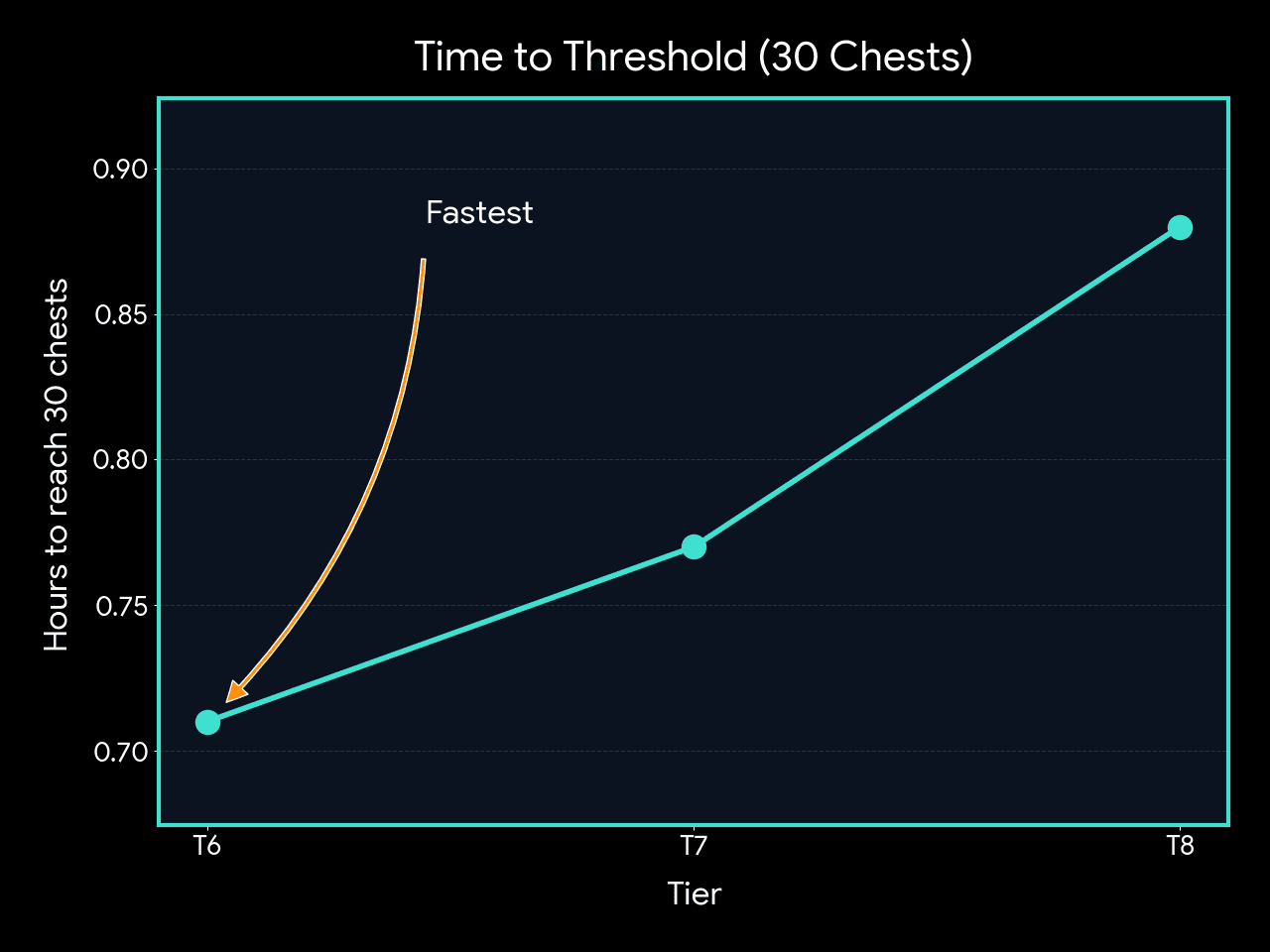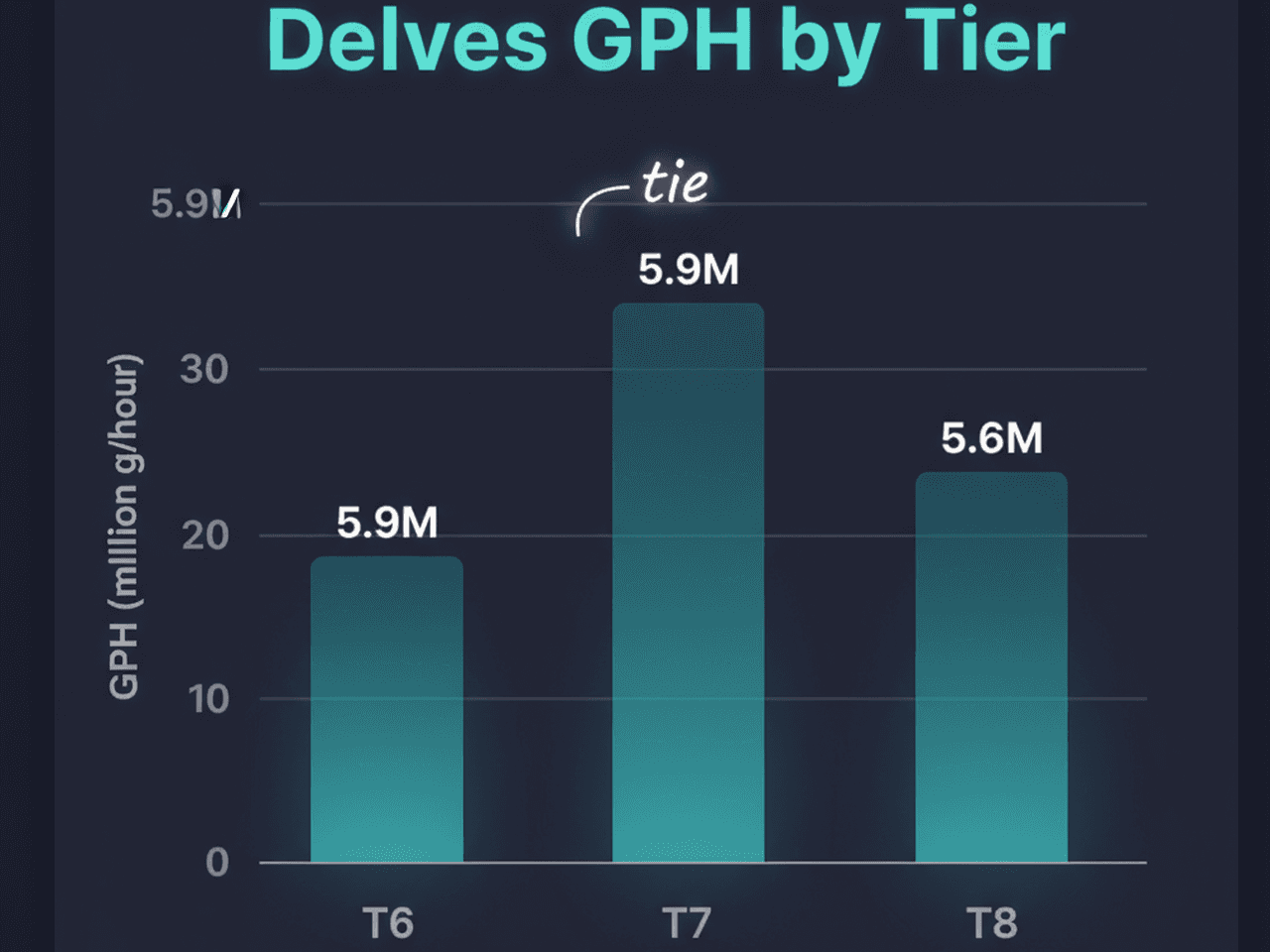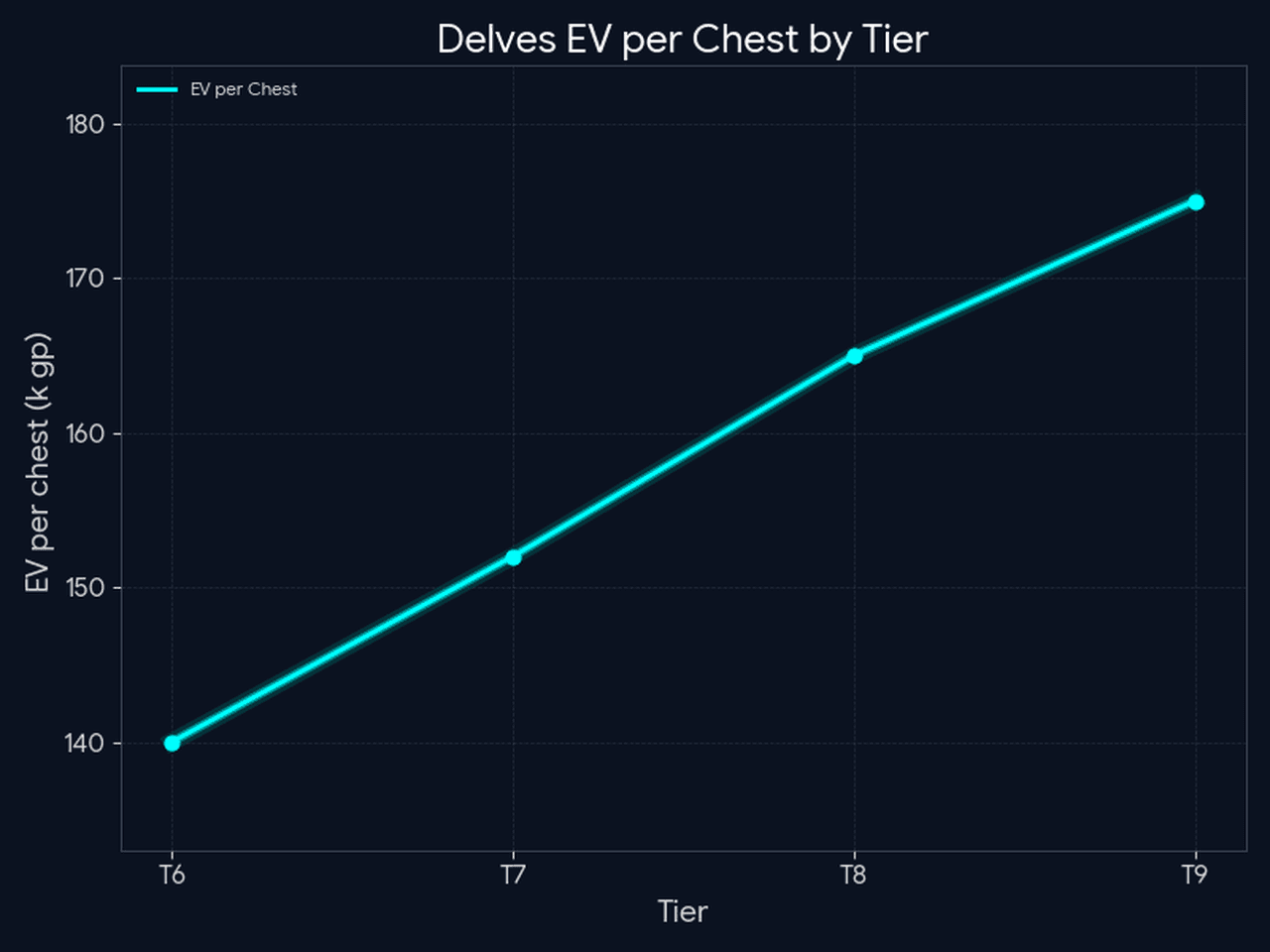
WoW Delves Weekly Vault — Tiers, Chest Thresholds & EV vs GPH Strategy
This guide demystifies WoW Delves Weekly Vault tiers and thresholds with practical, calculator-backed strategy. You will learn how many chests are needed per tier, how to plan routes that maximize GPH (gold per hour) instead of chasing misleading averages, and when to favor higher-tier delves vs faster loops. Use our WoW Delves Calculator to plug in your numbers and verify every claim. For definitions, see the EV, variance, and union probability entries.
Weekly Vault Basics — Delves Tiers, Chest Counts & Season Rules
The Delves Weekly Vault grants rewards based on tier (T6–T9) and the number of chests looted within the reset window. Each season may shift thresholds (e.g., "X chests for two choices"), but the logic remains constant: more chests unlock more and better choices. Because thresholds are discrete, optimizing your time-to-threshold is as important as optimizing your per-chest expected value.

Why thresholds change your route math
If it takes you 2.0 hours to hit your next threshold on a fast route and 2.7 hours on a slower, "richer" route, the slow route must increase your reward quality enough to compensate — otherwise your EV/hour suffers. This is the same idea we teach in EV vs GPH: Optimize Time in Loot Farming.
Tier choice: T6, T7, T8, T9
- T6 baseline: lowest incoming damage; routes are simple; great for threshold speedruns.
- T7–T8 middle ground: higher per-chest value but longer travel and tougher pulls.
- T9 prestige: highest per-chest EV, but variance and time cost increase; mistakes are expensive.
Key takeaway
Thresholds amplify the value of speed. When you are below a threshold, pushing faster chests/hour usually wins. Once the threshold is secured, you can explore richer paths for incremental upgrades.
Long-tail search notes
Players often search for "best delves weekly vault route T6" or "how many chests for weekly vault Sx." This guide uses calculator-ready language so your inputs directly map to our tool.
Internal links you'll need
Open the Delves EV & GPH Calculator, then compare threshold charts with the variance article to understand why short, consistent loops outperform high-variance routes for most solos.
Threshold Math — Time to Tier, EV per Chest & EV per Hour
Two clocks govern your vault progress: chests/hour and EV/chest. The former moves thresholds; the latter determines reward quality. Our calculator returns EV/hour as min(chests/hour, travel-limited runs/hour) × EV/chest with weighted cost/effort where applicable.

Time-to-threshold example
- Fast route: 30 chests threshold reached in ~1.9–2.1 hours (dense pathing, minimal backtracking).
- Slow route: same threshold in ~3.0 hours but with slightly better per-chest EV.
Result: unless the slow route provides clearly higher-tier vault options, the fast route yields more choices sooner and wins on GPH. For most players, hitting the threshold earlier dominates EV/chest differences.
Union probability for "at least one upgrade"
If a chest has upgrade probability p and you open n chests, the chance to see at least one upgrade is P(any) = 1 − (1 − p)^n. Faster routes increase n per hour, which increases P(any) and reduces perceived dry streaks.
Break-even rule of thumb
Every additional +5 seconds of travel per chest costs you roughly 8–9% of hourly attempts. Your EV/chest must rise by at least that much to break even. This is visible in our travel sensitivity chart.
Practical metric order
- Stabilize travel seconds per chest.
- Increase chests/hour until you comfortably clear the next threshold.
- Then bump EV/chest by choosing a richer tier or better chest mix if time allows.
Glossary refreshers
EV (expected value) is an average. Variance (spread) explains your lucky and dry hours. Thresholds transform averages into discrete jumps — plan for the jump, not the hour's luck.
Route Planning — Fast-Chain vs Safe-Cluster Archetypes
Your delves route matters as much as your tier. We use the same two archetypes we apply to other games, because the math transfers cleanly.

Fast-Chain (low travel, minimal backtrack)
- Inputs: travel 20–25s/chest, consistent chest pacing, straightforward pulls.
- Impact: lower EV/chest than T9 farms, but much higher chests/hour → faster thresholds.
Safe-Cluster (stable density, generous layouts)
- Inputs: travel 35–40s/chest, safer fights, occasional detours to richer rooms.
- Impact: EV/chest slightly higher but attempts/hour lower → needs better vault quality to break even.
Pick your tier with a purpose
If you are under a threshold, bias toward Fast-Chain at T6–T7. If you've locked your weekly threshold, experiment with T8–T9 to raise EV/chest without letting travel seconds creep up.
Travel time sensitivity
+5s ≈ −8–9% attempts/hour; +10s ≈ −16–17%; +15s ≈ −25%. Track this in the Delves Calculator while you test routes.
Solo vs party nuance
Parties smooth travel variance and split roles (scout, pull, loot), which lifts GPH stability. Solo players should prefer maps with linear pathing and avoid backtracking-heavy rooms.
Worked Examples — Plug-in Numbers You Can Reproduce

Example A: Threshold speedrun (Fast-Chain)
- Travel: 22–25s/chest
- Tier: T6
- Result: reaches weekly threshold ~35–40% faster than mid-tier "rich" route; vault choices appear earlier in the week.
Example B: Richer but slower (Safe-Cluster)
- Travel: 35–40s/chest
- Tier: T8
- Result: EV/chest higher; however, if routing drifts above 40s, GPH falls and time-to-threshold lags behind A.
When to switch chest mix
If your threshold is already guaranteed for the week, experiment with a richer tier or detours as long as travel seconds do not exceed your break-even window. Use the calculator's chart overlays to spot the cross-over.
When to move a few seconds back to travel
If you are missing the threshold by a small gap, cut a detour first. Regaining 5–10 seconds/chest usually beats small per-chest EV gains.
When to re-route entirely
If a season patch increases mob health or lowers chest density at your favorite tier, your old route might fail. Benchmark again: T6 chain routes often become the new weekly baseline.
Season Tables & Patch Notes Impact
Seasonal patches sometimes adjust chest costs, health tuning, or density. We snapshot defaults and show the last update timestamp in the calculator. You can override EV or time inputs at any time.
Costs & EV snapshots
Whenever notes change chest pacing or rewards, we refresh season defaults and mark the date. If your realm differs, override values locally and save the config via share link.
Known outliers
- "Bonus weeks" with unusually high density can make T8–T9 temporarily optimal.
- Nerfs to specific rooms may lower EV/chest but raise GPH if the pathing becomes more linear.
How to manually override EV safely
- Run three timed routes and record travel seconds/chest.
- Export your calculator CSV and adjust the EV/chest rows to your observed averages.
- Re-import (or re-enter) and compare GPH vs time-to-threshold.
When to reset to defaults
After hotfixes or if your CSV drifted far from current reality. The Reset Defaults button restores the latest season profile.
Where to check the change log
See the bottom of the calculator for the "Last updated" stamp. For broader explanations, visit the blog index.
FAQ — Weekly Vault Tiers, Thresholds & EV/GPH
Is T9 always better for the Weekly Vault?
No. If T9 slows your chests/hour, time-to-threshold suffers. Thresholds amplify speed. Hit the threshold first, then consider pushing T9.
How do I know when a "richer" route is worth it?
Use the break-even rule: if travel adds +5s/chest, your EV/chest must rise ~8–9% to break even in EV/hour.
Where can I see my inputs and KPIs together?
Use Export CSV in the Delves Calculator. It captures inputs (tier, travel seconds, chest mix) and KPIs (EV/hour, chests/hour).
What about variance and dry streaks?
Faster routes reduce dry streak pain by increasing attempts/hour. See variance and dry streak.
Should I play solo or find a party for thresholds?
Parties reduce travel variance and can increase effective chests/hour. If solo, choose linear routes and avoid backtracking.
Do I need to re-check thresholds every patch?
Yes, briefly. Patches can move density. Re-time your route for one session and update the calculator.
Related Reading & Tools
- WoW Delves EV & GPH Calculator — plug your tier, travel time, and chest mix.
- EV vs GPH: Optimize Time in Loot Farming — why EV/chest can rise while GPH falls.
- Glossary: Union Probability — the math behind "at least one upgrade".
- FAQ — data sources, assumptions, export tips.